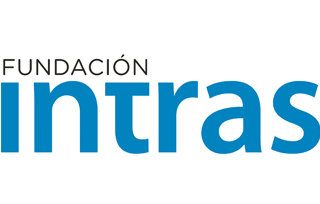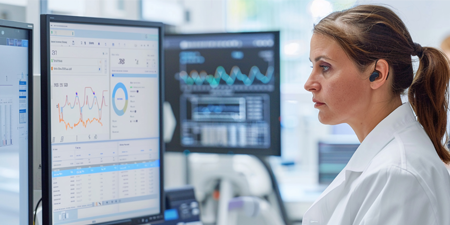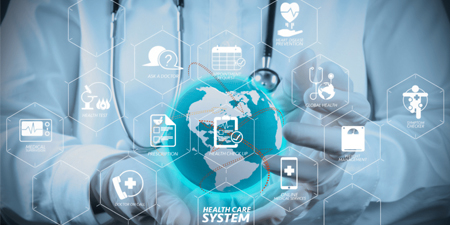DIGITAL HEALTH
The application of technology in the healthcare and medical fields represents a true revolution, as well as an advancement in the treatment of diseases and the evolution of diagnoses and treatments.

Digitalization and digital technologies are changing the way we perceive care and our own health. These tools offer new opportunities to monitor and improve care services, both in healthcare centers and at home. Additionally, digital technology also opens new opportunities for biomedical and clinical research, enhancing healthcare services.
Digital health, or e-health, is a broad concept that encompasses ideas from the intersection of digital technologies and healthcare. It applies digital transformation to the healthcare sector, incorporating software, hardware, and services. Under its umbrella, we find mobile health applications, electronic health records, wearable devices, telehealth, telemedicine, and personalized medicine. The future of the healthcare system will be connected, personalized, and data-driven. New technologies, such as artificial intelligence and augmented reality, will enable more efficient medical care, facilitating tasks like medical image analysis or faster evaluation of studies.
The technical solutions used are as varied as the medical topics, demonstrating their potential and even their degree of necessity. As an example, the following are highlighted:
- Data exchange platforms: They are intended to enhance research, diagnosis, and treatment of diseases by enabling the intelligent linking and exchange of information beyond the boundaries of clinics, outpatient care, rehabilitation, and nursing. At the same time, it is important to promote communication between professionals from different fields (including medicine, psychology, and physiotherapy), as well as between professionals and their patients.
-
- Telemedicine and Mobile Sensors: Their goal is to improve healthcare by easily reaching rural areas through the transmission of health data to doctors.
- The collected data will also help to better understand common diseases that are difficult to diagnose, such as mental illnesses and cancer, as well as to optimize therapies.
CLIENTS IN DIGITAL HEALTH















TECHNOLOGIES APPLIED TO DIGITAL HEALTH
Digital solutions in forecasting, diagnostics, and treatments
Digitalization and artificial intelligence (AI) are rapidly changing the healthcare system. In clinics, hospitals, and medical offices, electronic patient records, data management systems, AI-supported assessments, predictions, and resource planning, intelligent assistants, and many other technologies are on the rise. Doctors, healthcare professionals, and patients increasingly rely on cognitive systems, from the initial telemedicine consultation to AI-supported diagnosis, individualized therapy, and follow-up care at home.
Despite the current digital transformation in Europe and the increasing digitalization of the healthcare system, developing reliable AI is often challenging, especially in the field of medical imaging, because only small amounts of data are available. Training and testing AI models typically require large or very large amounts of data to achieve a high level of accuracy and reliability in AI decisions.
Algorithms can utilize enormous amounts of patient data. No human could process a comparable amount of data. This is why algorithms can recognize patterns that remain hidden to humans. For medicine, this means that an algorithm can recognize and calculate probabilities that a physician may not even estimate exist.
Active Aging
Measures to promote healthy aging include much more than just eliminating diseases; they also involve the active promotion of health throughout life and specific support to maintain functionality in old age. In the context of healthy aging, the term “health” refers to a person’s ability to do the things that are important to them.
Digital technologies offer enormous potential to shift from traditional medical routines to telemedicine and transform our ability to manage health and independence in aging populations. The role of wearable devices is particularly relevant in helping older adults monitor their health and maintain independence at home.
Wearables can assist older adults in remotely tracking chronic illnesses or ongoing treatments and monitoring safety issues, all without interrupting daily activities. For example, wearable platforms can continuously and non-invasively capture biometric and biomolecular data, which is not possible with traditional health assessments. They can generate instant alerts in emergencies, such as a stroke, seizure, or fall, allowing for timely medical interventions. These tools are also expected to reduce geographical inequalities by providing older adults living in rural areas with better access to healthcare services.
Electronic product development
The application of digital technologies to assist clinical practice can address the increasing demands in service by providing convenient and continuous remote healthcare to patients and holds great promise for transforming healthcare.
Wearable sensor devices capable of real-time monitoring of various aspects of health or user behavior have attracted enormous attention over the last two decades due to their diverse applications. Wearable sensors have rapidly evolved since the advent of the Internet of Things and mobile devices, from the early trackers of user mobility and vital signs to today’s advanced multimodal detection devices capable of generating valuable data that were impossible to obtain just a few years ago.
Continuous and remote monitoring of vital signs can generate alerts for adverse events and deterioration of conditions in older adults, including the early onset of cardiovascular, neurological, and pulmonary diseases. For example, abnormal respiratory rates can predict respiratory failure, elevated body temperature can indicate an infection, and abnormal patterns in electrocardiogram signals can alert to cardiac arrest.
While digital technologies promise to revolutionize geriatric care, their practical implementation faces significant challenges, including a lack of digital literacy, threats to data privacy and security, and the limited performance of devices. Overcoming these challenges is crucial for the widespread use of digital technology in geriatric healthcare.
OUR PROYECTS
ANASTRA – Research on new technologies for real-time analysis of agricultural soils to calculate CO₂ sequestration capacity
ANASTRA is a research project that brings together ITAGRA and ITCL to develop an autonomous robotic platform with hyperspectral sensors and digital technologies. Its goal is to accurately and in real time measure the capacity of agricultural soils to act as CO₂ sinks.
Duration: September 2024 – August 2027
BIOTECARE – Data-Driven Technological Advancement for the Optimization of Biotechnological, Healthcare, and Care Processes
The project aims to drive research and development of innovative solutions based on data science, AI, and Deep Learning to enhance the integration of medicine with these technologies. This will improve how diseases are diagnosed, treated, and prevented, as well as optimize overall healthcare management and patient experience.
Duration: 2024 - 2026
AI4HOPE – Artificial Intelligence based health, optimism, purpose and endurance in palliative care for dementia
AI4HOPE focuses on implementing an Advanced Care Planning System for dementia patients and caregivers, integrating emotion regulation and pain management with AI models to improve care while recognizing dementia as a life-limiting disease.
Duration: 2024-2027
Sudoe Hospital 4.0 – Intelligent Energy Management in Hospitals
Hospitals are buildings of continuous use, which have very specific air conditioning requirements in their different spaces and are conditioned to a climatological evolution characteristic of the Sudoe territory. Inefficient management or their inadequacy lead to incensive costs, avoidable emissions and inefficiency of public investment in their construction and maintenance.
Duration: October 2019 - March 2022
PREVENT – Prevent Cancer by Managing Childhood Obesity
PREVENT enhances the scale-up of primary interventions for weight control during childhood and adolescence to reduce cancer risks in adulthood
Duration: 2023-2027
HosmartAI – Intelligent Hospital Development
The HosmartAI project will create a common open integration platform, with the necessary tools to facilitate and measure the benefits of integrating digital technologies (robotics and AI) into the healthcare system.
Several large-scale pilot projects will make it possible to evaluate the various improvements in several hospital environments:
Medical diagnosis, surgical interventions, disease prevention and treatment, rehabilitation support and long-term care.
Duration: 2021 - 2024
VIRTUALIZA – Virtual Training Platform for SME´s
Virtualiza arose from the need to offer more personalised training to users with certain dependencies or functional limitations, such as the elderly and people in vulnerable situations in general
Duration: 2021-2022
TRIAGE SMART DECISION – AI Based COVID Triage System for Hospitals
Carrying out prior triage in hospital emergency services, through artificial intelligence techniques, carrying out the first screening and differentiation of COVID or non-COVID users.
Duration: 2021 - 2023
IBERUS – Biomedical Tech for NMS Degeneratice Pathologies
IBERUS is the name of the Network of Excellence of the 4 Technology Centers (CCTT) that have defined a Strategic Program with the aim of stimulating the Cervera 15 Priority Technology, framed among the technologies for health, both in the research and development activities of the centers themselves and in the business and clinical context
Duration: 2021 - 2023
Cama UP – Tech fot Enhanced Personal Mobility
Cama UP aims to improve personal autonomy in basic activities of daily living for certain people with functional mobility. The innovative CAMA-UP technological system aims to help certain people in this group to be self-sufficient in these actions, avoiding the help of the main caregiver or third parties for this purpose and promoting their autonomy and personal independence.
Duration: 2020-2022










